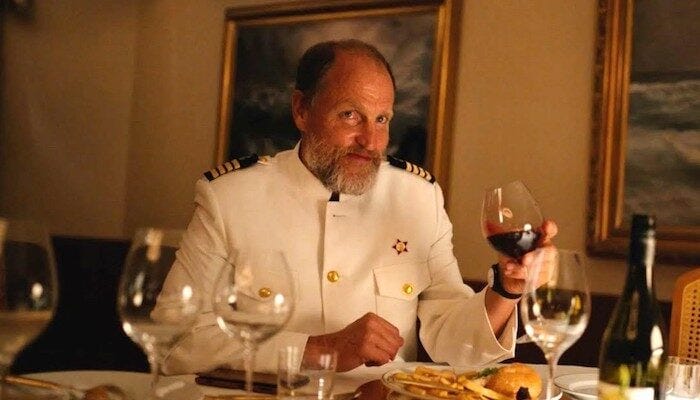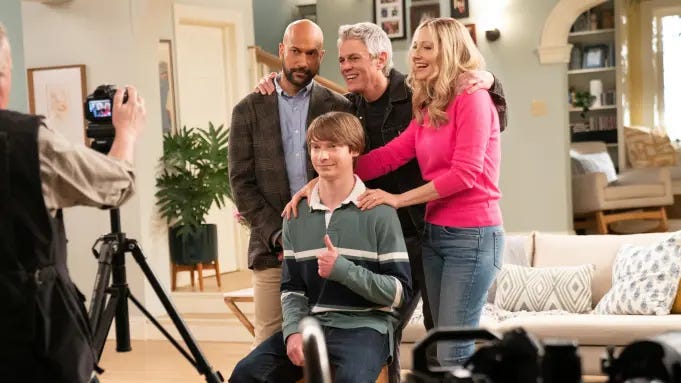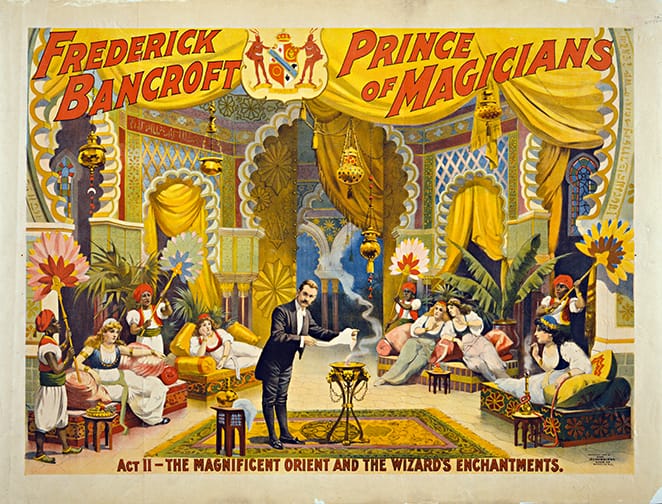"Triangle of Sadness" Reviewed

Review: Triangle of Sadness
Given the centrality of seafaring to the plot of Triangle of Sadness, I presumed the title could refer to a sort of Bermuda-esque mysterious zone of metaphysical entanglement the characters might stumble into. And, indeed, the ensemble of varied (but almost uniformly spoiled) passengers do find themselves in fairly dire straits, so maybe there’s a play on words there after all. But we learn early on just what, specifically, the triangle of sadness is: it’s the point between the eyebrows where the film’s protagonist, fashion model Carl (Harris Dickinson), seems to be holding his stress—the triangle of sadness is what he’s told to relax by a casting agent. But Carl would seem incapable of letting go of his triangle, and that existential stress will stay with him across the 2.5-hour span of writer-director Ruben Östlund’s quite literally nauseating satire. The only thing that will change is what type of stress Carl’s triangle will be responding to.
At the outset, Carl is stressed by the resistance of his girlfriend, Yaya (Charlbi Dean), to fulfill her promise of picking up a dinner bill. The sequence goes from mild comedy of manners to agonizing cringe comedy; for the majority of the scene, I found myself thinking of Tim Robinson’s Netflix sketch show I Think You Should Leave, and the comparison is appropriate to any number of scenarios in Östlund’s films, stories in which characters are constantly making themselves a problem for one another and then flailing as they try to navigate their way back to social safety.
The incident between Carl and Yaya concerning the dinner bill goes on so long that the comedy falls away and we arrive in a place of surprising catharsis. It’s just one of many scenes that Östlund allows to continue playing and playing long past the point many directors might look away; he seems fascinated by what happens when people are forced to wait and squirm, whether that be his characters, the audience, or both.
Carl and Yaya soon find themselves on a luxury cruise, paid for by Yaya’s work as an Instagram influencer. It’s onboard the ship that Östlund shows his cards: what we have on our hands is an eat-the-rich satire in which the extremely wealthy are demonstrated to be cruel, selfish, hypocritical, or all three, and then punished for their transgressions. It’s a sturdy formula, one that’s led to any number of great films, from The Discreet Charm of the Bourgeoisie to Ready or Not. Östlund, though, doesn’t seem to have anywhere in particular to go from there.
The film’s centerpiece is a spectacularly long, spectacularly revolting sequence of mass seasickness. This display of excretion is so extended and so detailed that vomit bags have been passed out at some screenings of Triangle of Sadness. Before watching the film, the puke bag gimmick struck me as just that: a cheap (and wasteful) way of emphasizing the movie’s intended gross-out framing. And yet I wouldn’t be surprised if I found myself needing one of those bags in a theatrical setting—as it was, watching on a screener, I still found my stomach cramping early on, and that cramping only got more severe as the sequence continued (and continued and continued). I remained nauseated for at least an hour afterwards, and my stomach is shifting uncomfortably as I write these words. The seasickness extravaganza really is that upsetting. I suppose I should congratulate Östlund on achieving his presumable goal of directing the most disgusting film imaginable; whether it’s effective to create art that the viewer is compelled to look away from, and hence totally disengage with, may be a matter for some debate.
After a certain point, the scene of seasickness is soundtracked by the ship’s captain (Woody Harrelson), who reads Marxist theory over the PA system while his guests loll dazedly in their own fluids. Ruben Östlund’s knows writers who use subtext, and they’re all cowards. As with the early restaurant sequence, Östlund lets the scene go on far, far longer than one might imagine, and the effect is something like being bludgeoned.

From there, the film shifts into its third act, which finds a handful of core ensemble members forced to fight for their survival. I won’t say more than that (though the trailer does), but I will say that in this final stretch, Triangle of Sadness comes to basically work from my perspective. Östlund’s slow and patient setting up of character detail is allowed to pay off, an effect that’s almost like sleight of hand as early scenes that felt like throwaways now come due in a cascade. The entire narrative deck is reshuffled and the new dynamics and conflicts zap some life into a movie that’s badly sagging after what must surely be a Guinness-record-setting volume of effluvium. It’s not enough to retroactively convince me the entire thing works, and certainly not enough on its own to make me want to recommend the movie. But after a middle chunk that I’d say literally and figuratively blows chunks, it was nice to be rewarded with some storytelling pleasures and surprises.
It was hard for me not to think of The White Lotus during the languid and lazy class satire of Triangle of Sadness’ middle third. But compared to Mike White’s zeitgeisty anthology series, Östlund’s film comes across as flat and thinly-sketched, lacking in precision and detail. Having made the groundbreaking suggestion that some people lie about their lives on social media, Östlund seems to run out of narrative rope, leaving himself dangling without a point to land on. I may not be half the looker that Carl is—and his good looks will prove an asset in the film’s climax in ways he never would have expected—but my own triangle of sadness was bunched and heavy during this (inexplicably, for my money) Palme D’or winning film.
Triangle of Sadness opens in select theaters tomorrow, October 14.
Sundry Ephemera
My wife and I have recently been watching the new Hulu comedy Reboot. It’s from Steven Levitan, a creator of Modern Family, and it’s not hard to make that connection while watching the show—everything from the camerawork to the scoring screams early-’10s single-camera sitcom (if only it were a mockumentary we’d really have a bingo).
The show concerns the reboot of a popular early ‘00s network sitcom—there are complicated plot machinations in the pilot explaining how and why the show was rebooted, but the scaffolding falls away quickly to leave a sturdy foundation for a showbiz workplace comedy. I wouldn’t necessarily say the show is terribly funny so far, but I’ve been surprised by how much I enjoy watching it—the ensemble is stacked with ringers, including Keegan-Michael Key, Judy Greer, Paul Reiser, and Rachel Bloom, all of them doing what they do best. But the real wild card is Johnny Knoxville, who…well, I wouldn’t call him good necessarily, and he might in fact be pretty bad on a technical level, but there is something fascinatingly odd about his performance, which is intensely earnest while seeming oddly detached. It’s never anything as pedestrian as awkward or grating; it’s more just something unlike anything anyone else is doing, and I’m glad he’s doing it, even as I’m puzzled.

I’m also puzzled by the surfeit of cursing. It seems strange that a show so seemingly built from a network primetime template should have quite this many fucks and shits in it. I’m not clutching my pearls here, it just feels odd, and takes some getting used to. But what you’re getting used to is, essentially, hearing people on a sitcom talk like real human beings, free of the frickins and craps that stand in for profanity on most shows and stick out like a sore thumb for their G-ratedness. I guess it’s theoretically a shame that a kid couldn’t enjoy Reboot, but it’s also an enjoyable novelty to see a basically traditional sitcom that’s not even pretending to be for the whole family.
I’ve also been listening to a lot of Frank Turner this week. A former member of hardcore band Million Dead, Turner is now a…well, adrenalized singer-songwriter, I guess? He has a real tendency to scream and yell, befitting his hardcore roots, but it’s all backed up by the sort of jaunty strings and pounding piano more reminiscent of a Mumford and Sons or a Lumineers. There’s nothing particularly original about Turner’s music, and certainly nothing cool, but I find something immensely appealing about just how uncool he can be.
Turner’s lyrics have a tendency to be painfully blunt, which works to their advantage in the best case (my favorite of his songs, “Recovery,” which is just a straight-talk stroll through the agonizing process of getting better) while serving to make some songs completely unlistenable (one recent single includes the refrain “Make America great again/by making racists ashamed again”–good one, Frank). That unsubtlety just testifies to how absolutely forthright and open-hearted Turner seems to be, though. I’ve been gravitating this week to “Peggy Sang the Blues,” a track off 2011’s England Keep My Bones, and that song’s refrain (“No one gets remembered for the things they didn’t do”) is both obnoxiously aphoristic and ridiculously sing-along-able, the central paradox in Frank Turner’s music that makes me often want to cozy up with it at this time of year, just as the mist starts rising and the leaves start falling.
Oh yeah, also…
Read Zosha’s grand unified theory on Mike Flanagan!
Eric Langberg’s new personal essay on queer B-movie Siege for BW/DR is a knockout.




